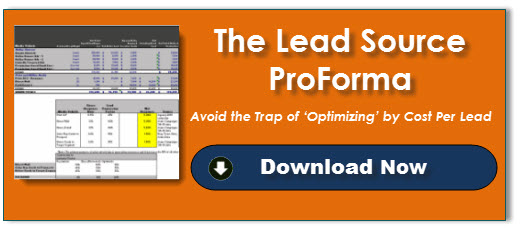Marketing teams work to drive inquiries into the top of the funnel. CMO’s are often presented click metrics and reports from their team on how campaigns are optimized. However, this is an area that many marketing teams lack sound processes. This can result in corrupted analysis that de-optimizes a campaign. How their teams should analyze Lead Sources is a major concern for marketing leaders.
Optimization is often performed through cost and click metrics. These metrics are good leading indicators but can be a death trap for optimization.
Click-through rates, conversion rates, and cost per lead are commonly used as fine tuning points. However, these are simply the tip of the iceberg.
Optimizing Lead Source by leading indicators is short-sighted for two reasons:
- Focuses on the cost of the input while ignoring the output
- Ignores the competitive reality of bidding that impacts CPL
The ultimate success metric should be outcome focused, not cost driven. View the generation of leads in context of their conversion to qualified Opportunities for the sales force. Leads should be tracked to Opportunities and Wins. This seems like a no-brainer, but CMO’s struggle with managers who optimize with only input data. The result is often the de-optimization of a campaign.
Why Higher Click through Rates are Not Always Best
Targeting c-level decision makers can involve low early conversion rates. If the target is elusive, then the conversions will be dismal. But once converted, these clicks that fit the Ideal Customer Profile can accelerate through the pipeline. The end result may be a high yield margin campaign.
Why Cheaper is not Better
The goal is not to drive the cheapest leads. The goal should be the efficient production of qualified leads that drive revenue. It’s all about net new logos and upsell to existing customers — forget the cost per lead as the focus.
Real Indicators of Success
Capture the total impact of all touch-points and activities within a campaign. A common mistake is to attribute total success to the original lead source without careful analysis of the chain of events. That’s where SBI’s demand generation programs benefit from ProForma Lead Source assessment tools.
Demand Generation teams should focus on these metrics:
- Cost per qualified Sales Ready Lead
- Conversion rate of Lead to Opportunity segmented by source or mode (Email, direct mail, social media, field event, etc.)
- Lead generation contribution of revenue as a % of the sales funnel, and as a % of wins
The concept of a Lead Source ProForma is to capture all aspects of a campaign into a single view. The ProForma provides a framework to capture all campaign activity, associated costs, and click metrics. This provides a comprehensive view to drive an ROI equation.
The Tale of Two Lead Sources
The following is an example scenario to demonstrate the trap involved.
Lead Source 1 – Google Adwords
(Click image to enlarge)
In this example, the Google Adwords have a Cost per Lead of $552. This is almost double the cost of Online Banner Ads, Email and Direct Mail in this example. It would seem that a prudent marketing manager should reduce spending, right? Wrong.
Look further at the right side of the equation. The leads from Google Adwords in this example convert as a 3x rate of the other tactics. This is common as Adwords drive visitors who have Active interest. They were already stimulated when they began their search.
Going further, the ROI of the Lead Source is 461%, more than double the other tactics.
In this case, a marketing manager not guided by their CMO may de-optimize the marketing campaign. CMO’s must validate that their teams are not optimizing off early indicators
Lead Source 2 – Online Banner Ads
In this second example, the Cost per Lead of Online Banner is fantastic. At half the price of Google Adwords, it would make sense (or so it seems) to transfer dollars. Without the right technology and Lead Generation processes in place the marketing team can be blind. With the output side of the equation (Right side), the ROI drops to half that of Adwords.
Imagine the damage that can be done de-optimizing campaigns.
Action Plan – Download the Lead Source ProForma.
CMO’s should pay close attention to marketing managers who brag about their high CTR’s and low CPL’s. Dive deeper to quantify the input and output. Leverage this post and the tool to help your team thrive with campaign lead source optimization.





![[Research Round-Up] The Latest From NetLine On B2B Content Consumption](https://customerthink.com/wp-content/uploads/email-g56aa02a47_1280-pixabay-email-marketing-218x150.png)
